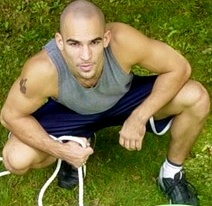
Be "Smart" When Training
By Ross Enamait - Published in 2003
I’ve received several emails from individuals regarding the specifics of a boxing workout. I appreciate the interaction and encourage it. I would like to emphasize however that no single workout satisfies the needs of all boxers. Each fighter has unique strengths and weaknesses. A tall, rangy boxer who circles the ring will train differently than a short, brawling fighter. It is important to tailor the workout towards your specific needs.
When planning a workout, always keep your goals in mind. If you wish to become a competitive boxer, you must train accordingly. I cannot overemphasize the importance of practicing your trade. All the weight lifting and running in the world will not make you a champion. The best way to improve at this sport is by stepping inside the ring to practice.
My advice is to fight regularly in the amateurs and focus on mastering the fundamentals of the sweet science. With this said, it is difficult on your body to continuously spar and fight in tournaments. This means that you must modify your training routine to adapt to the stress that your body will endure. You must train smart to be successful. I was fortunate to work with several excellent boxing trainers throughout my life. Despite my fortune, there were times when only I knew how my body felt. The body is the ultimate feedback mechanism. If you are tired or worn out, the body will tell you. You must learn to listen to its advice.
A typical boxer’s routine will include morning running, followed by an afternoon trip to the gym. Training will consist of shadow boxing, heavy-bag drills, focus mitt work, speed and double-end bag drills, jump rope, and actual sparring. You may also incorporate strength training and conditioning drills into the weekly mix. Each day will include something slightly different. For example, one day you may practice fighting against a left handed boxer by circling to the left and throwing lead right hands. Another day, you may practice fighting on the inside with short hooks and uppercuts.
Do not become so structured that each workout is identical. Eventually, you will begin to “go through the motions” rather than training with intensity, and the desire to improve. We all have weaknesses that must be addressed and improved. Work on your weak points, rather than spending the entire workout throwing the combinations that you have already mastered. If you cannot box while moving to your right, practice this movement for an entire workout. Practice moving and throwing all of your combinations in this direction.
In addition, if a fight is coming up, you will likely spar 3 to 4 days per week with more rounds than usual. You may need to ease up on the morning running routine to accommodate the extra sparring. There is a fine line between training hard and over training. Over the years, I've crossed this line several times. I have learned through experience that sometimes it is best to back off when my body is in need of rest. This is particularly true if you have a busy sparring schedule. Hard sparring takes priority. There is no shame in postponing a morning of interval training if you have a big sparring session planned for later that day. You are not training for a road race. You are training to fight. Focus your energy on boxing. If this means you must lighten up on your roadwork, you need to make the adjustment
Always remain flexible and improvise your routine to maximize results. Modify your routines according to the goals and weaknesses you must overcome. Strength and conditioning workouts are excellent, but they are not a replacement to more conventional training. These drills should supplement the overall routine of a boxer. I could take a man off the street and put him through the most rigorous running and weight lifting routine for an entire year. This man would be in great shape, but he would not be a boxer. Boxing involves is a combination of strength, stamina, power, speed, and most importantly SKILL.
You must pay your dues in the gym and learn the fundamentals of the sport. Conditioning drills will only benefit those fighters who master the fundamentals. Boxing is a sport that relies on skill and strategy. Conditioning drills will help you perform at your best, but you need skill to apply your conditioning. Learn what to do inside the ring, and let the conditioning drills prepare your body to perform round after round.
Be smart when training by mastering your skills while conditioning your body. Different opponents will require different fight plans, thus different training routines. Recognize this fact and work with your trainer to devise a routine that targets your objectives. Don’t underestimate the intelligence that you will need both inside and outside of the ring. Smart fighters equate to good fighters.
Train hard, but most importantly train smart.
 About the Author - Ross Enamait is an innovative athlete and trainer, whose training style is among the most intense that you will find. Ross is committed to excellence and advancements in high performance conditioning and functional strength development. He has a sincere interest in helping today's athlete in their quest for greatness.
About the Author - Ross Enamait is an innovative athlete and trainer, whose training style is among the most intense that you will find. Ross is committed to excellence and advancements in high performance conditioning and functional strength development. He has a sincere interest in helping today's athlete in their quest for greatness.